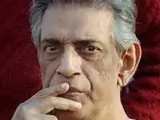Jean Renoir was a major influence on Ray. Renoir was the first European director who warned Ray against Hollywood influence in Indian films. Renoir had noticed how the Indian film industry was churning out melodramas to cater to the taste of ever-enthusiastic Indian public. But he was optimistic that better films were going to be made and he blamed the current state of affairs on the Indian directors who found more "inspiration in the slick, artificiality of a Hollywood film than in the reality around him." Of all the films of Renoir, Ray admired La Regle du Jeu the most, a personal favorite of Renoir himself. Regarding filmmaking Renoir said that a filmmaker need not show a lot of things in a film but to show only the right things. Ray diligently followed the same advice that Renoir offered him in 1952: "You don't have to have too many elements in a film, but whatever you use must be the right elements, the expressive elements." From Renoir, Ray learnt that there was nothing more important to a film than the emotional integrity of human relationship in the film. No doubt technique was important but he said that it should not become the dominant force. "In America," Renoir said, "they worry too much about the technique, and neglect the human aspect."
Apart from Renoir, it was the Italian Neo-Realists who gripped Ray's imagination next. Ray noted in his book that his trip to London as an art director of an advertising agency was to seal the fate of his advertising career. He said that within three days of his arrival he had seen The Bicycle Thief by Vittorio De Sica which furthermore strengthened his resolve to make his first feature film Pather Panchali using natural locations and unknown actors as was the case with The Bicycle Thief. Ray says: "All through my stay in London, the lessons of The Bicycle Thief and neo-realist cinema stayed with me." Ray's praise for The Bicycle Thief knew no bounds as he says: "BT is a triumphant discovery of the fundamentals of cinema and De Sica has openly acknowledged his debt to Chaplin." He found that the universality of the theme, the effectiveness of the treatment and the low-cost production made it an ideal film to be used as a model by the Indian filmmakers.
Curiously, one of Ray's earliest introduction to sound films and one of the earliest influence in filmmaking was Lubitsch's Trouble in Paradise. Ray pointed out that with the introduction of sound on film it was Lubitsch who integrated a story and the song to form a whole new work of art. Ray admiringly talked of Lubitsch as a director with "all wit and elegance and innuendo," "a director who had a permanent influence on all future filmmakers of sophisticated comedy." Incidentally, Lubitsch was also one of the few top rated European directors to really succeed in Hollywood.
In Calcutta, Ray often used to drop by Jean Renoir's hotel-room during the evenings to discuss Europeans films and filmmakers. Renoir would point out the distinctive and specific features of the landscape of Bengal which symbolised the essence of Bengal. For instance, a clump of banana trees, a small pond in a village or a waving paddy was quintessentially Bengal to Renoir. Like in Renoir's The River, the placid Ganges is a recurrent symbol in Ray's films including Aparajito. The film, shot in Benares, continuously shows man's dependence on the river as a source of life. Renoir even told Ray that if Indian filmmakers could get Hollywood out of their system, they would be making great films. (Marie Seton, Satyajit Ray, OUP, 1974; p. 145)
True to Renoir's advice, Ray focused on details which typified the city and the village in Bengal. The vast plains of Bengal, the rivers, the monsoon rains, and heavy moisture-laden clouds formed the backbone of Ray's earlier films.
In Pather Panchali, Ray introduced the neo-realist tradition of using non-actors and actually shooting on location while using an unadorned style of photography. The details of speech, behavior, habits, customs, rituals, substantiated the very simple structure and the narrative line. The film, almost a documentary, was simple enough to be comprehensible at all levels. Incidentally, the novel Pather Panchali by Bibhutibhushan Bandyopadhyay, from which the movie was adapted, was a sprawling saga whose slow speed, leisurely denouement caught the perfect rhythm of the rural Bengal.


























